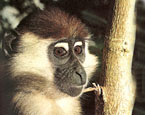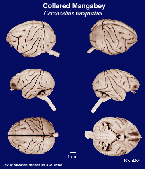|
Collared
(Sooty) Mangabey
(Cercocebus torquatus) #63-489 |
||||
|
|
Physical
characteristics and distribution
|
|
The Collared (or Sooty) Mangabey is native to tropical forests. It lives on the ground and lower layers of the forest in small groups of 4-12 individuals. It is a very social animal with a highly developed communication system. It actively communicates with other individuals through shrieks and facial gestures. The Sooty mangabey is sure-footed, moving easily among the tree branches. Its tail is partly prehensile allowing it to keep ahold of branches. The leopard is its primary threat. Their
diet consists of palm nuts, seeds, fruit and leaves. Breeding takes place at any time of year, with a single youngster being born after about 6 months, fully furred and with its eyes open. The mother gives birth wherever she happens to be, and birth is usually at night. She eats the placenta and licks the baby clean as it clings to her belly. Other females in the group show great interest and try to hold new infants. Nursing becomes less frequent after the first few months, but continues until the next birth, usually after 2 years. They are found from W Nigeria to Gabon. |
|
Description
of the brain
|
|
Animal
source and preparation
|
|
All
specimens collected followed the same preparation
and histological procedure.
|
Other Related Resources (websites and publications)
List of Specimens | Explore Collections | Brain Sections | Brain Evolution | Brain Development | Brain Circuitry | Brain Functions | Location and Use | Related Web Sites | Contact Us | Search MSU Database | Personnel | Home


